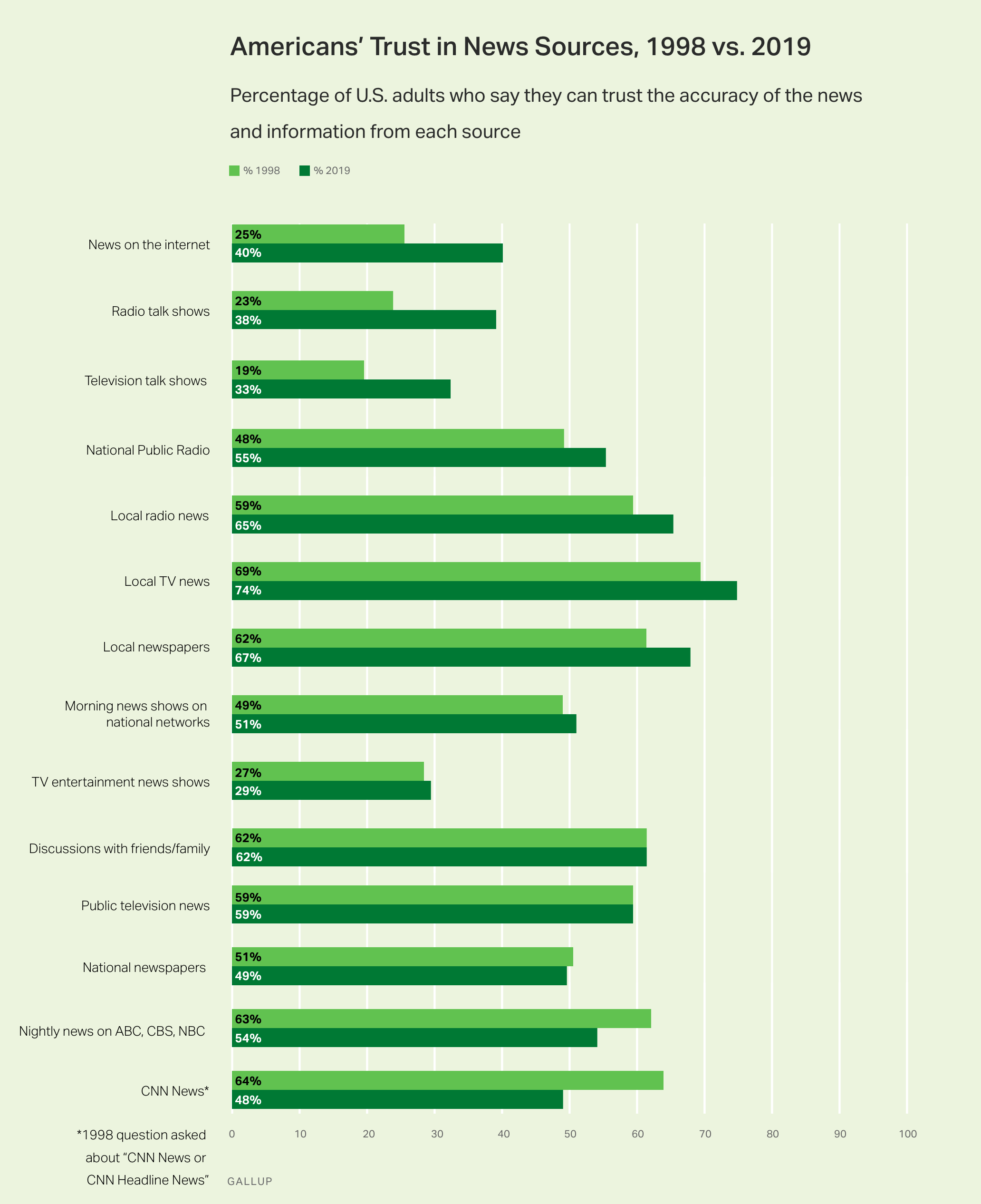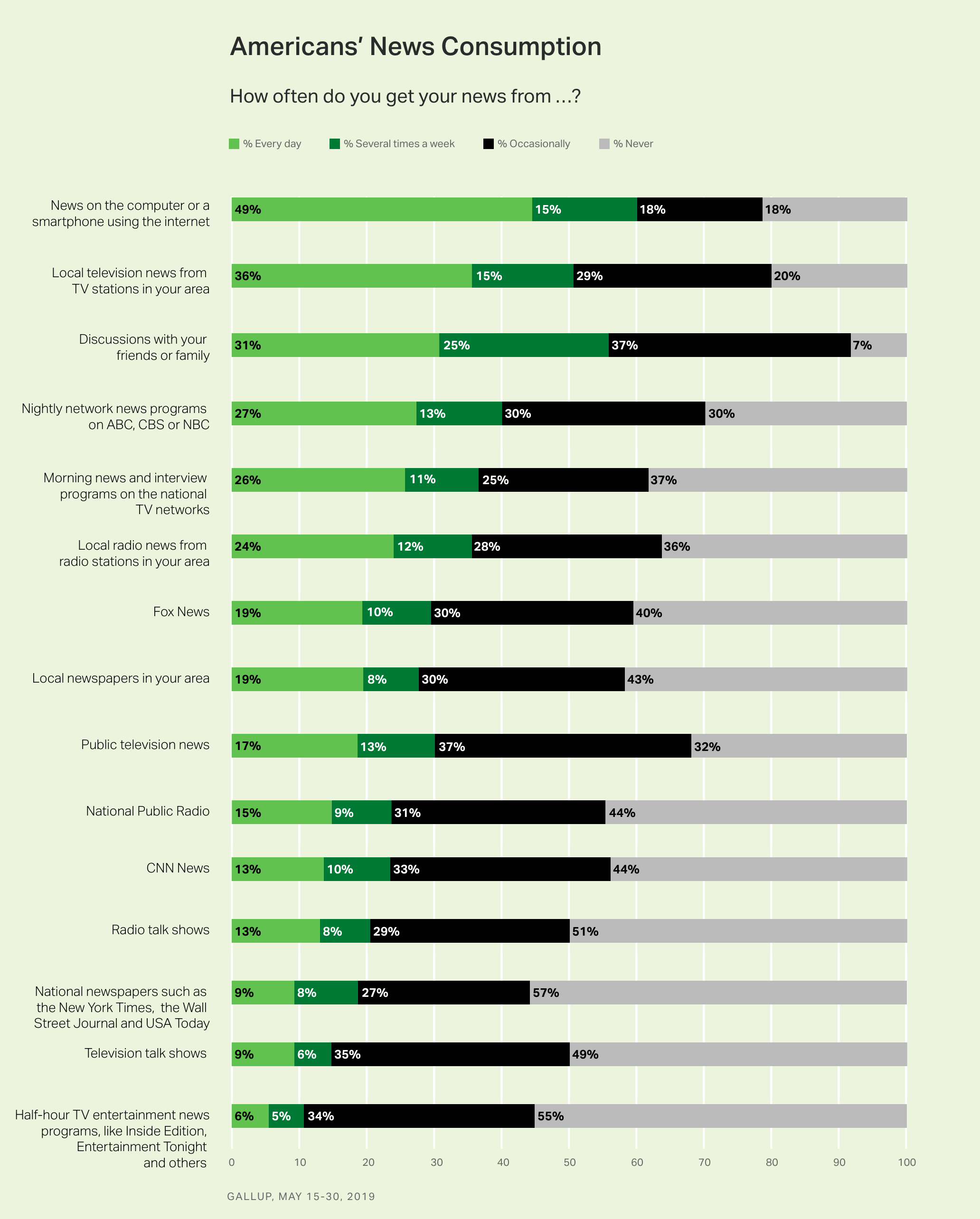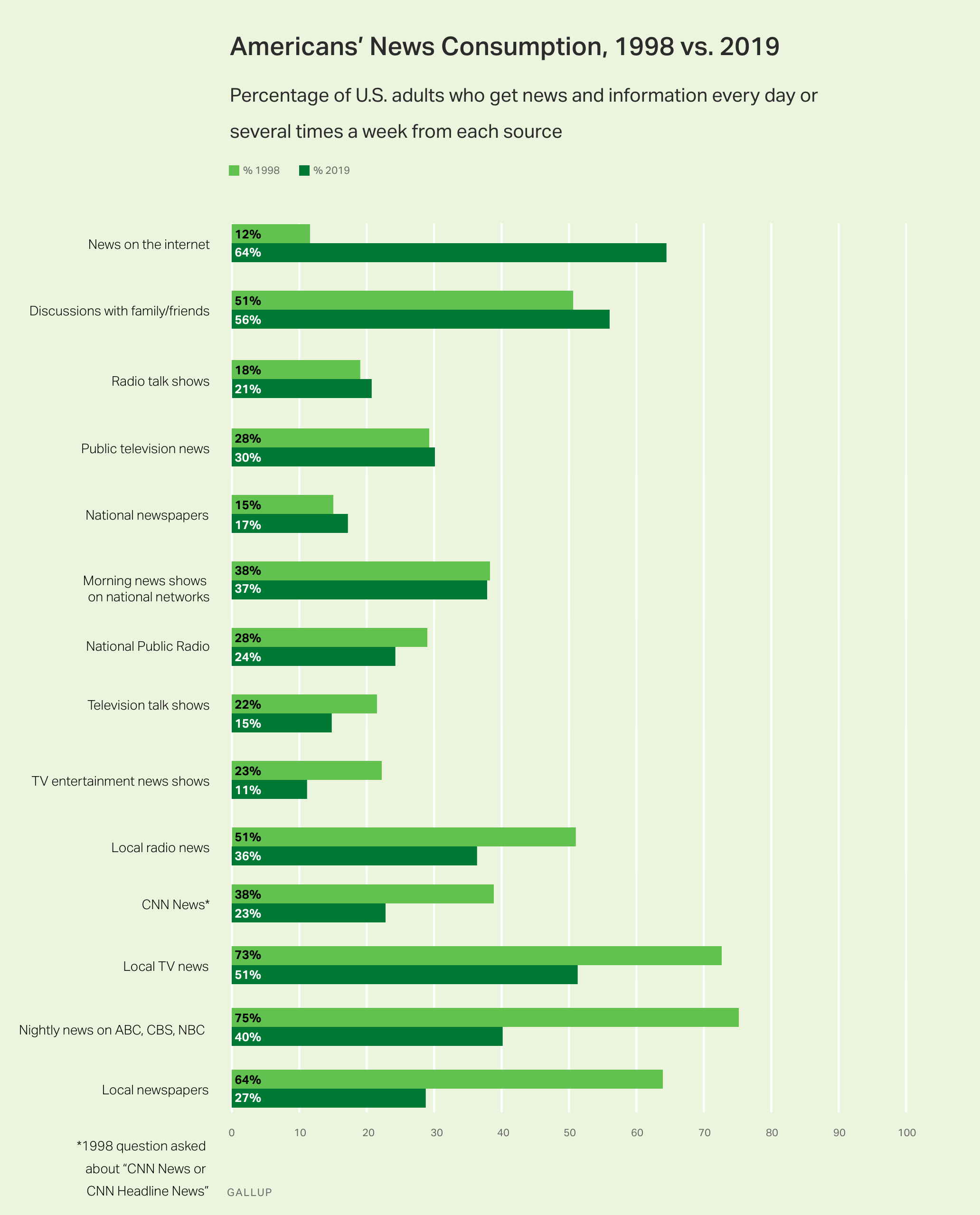Story Highlights
- Trust in online news, talk shows on radio and TV rose most over 21-year period
- Three local news sources -- TV, newspapers, radio -- garner most widespread trust
- In 1998, 12% in U.S. used online news; 64% currently do
WASHINGTON, D.C. -- Many more Americans trust news on the internet than did so in 1998, when only a small fraction of Americans got their news this way. Currently, 40% of Americans say they trust online news, up from 25% in 1998, the last time Gallup measured opinions on the subject. Since 1998, Americans' use of the internet as a news source has grown more than five times compared with what it was.
Trust in talk shows on radio and television each also rose by double digits over the same period. Meanwhile, of the 14 news sources tested by Gallup in 1998 and 2019, CNN and network nightly news shows were the only ones to become significantly less likely to be trusted.
Of 15 news sources measured in Gallup's May 15-30 poll, three local sources -- television, newspapers and radio -- engender more widespread trust than any of the dozen other sources. Local sources were among the most trusted in the 1998 survey, but all three did not sit atop the list as they currently do.
Americans' Trust in News Sources
In addition to local television (74%), local newspapers (67%) and local radio (65%), several other news sources garner majority-level trust from the public. They include discussions with friends or family (62%), public television news (59%), National Public Radio (55%), nightly network television news programs (54%), and national morning television network news and interview shows (51%).
Fewer than half of Americans say they trust national newspapers (49%), CNN (48%), Fox News (43%), online news (40%), radio talk shows (38%), television talk shows (33%) and half-hour television entertainment news programs (29%).

The largest percentage-point increases between 1998 and 2019 in Americans' trust are in online news (+15) and talk shows on radio (+15) and television (+14). Yet more Americans also now trust National Public Radio (+7) and local radio (+6), local television (+5), and local newspapers (+5).
Trust in CNN (-16) and nightly network news (-9) dropped over the 21-year period. Gallup did not include Fox News in the 1998 polling, so it is unknown whether trust in it has increased or declined in the past two decades.
The remaining five news sources saw negligible or no changes in trust. These include morning network news shows, half-hour entertainment news shows, discussions with friends and family, public television news and national newspapers.

Partisans' Trust in News Sources
A comparison of the rank order of partisans' trusted news sources finds that local television news is at the top of the lists of Republicans, independents and Democrats. Majorities in each party also trust local radio, local newspapers, and discussions with friends and family.
Republicans are generally much less trusting of news outlets and reach majority-level trust only for one additional source: Fox News. Conversely, majorities of Democrats trust 10 of the 15 sources, and at least half of independents trust eight of them. Democrats are much more trusting than their counterparts of nightly network news and CNN.
| Republicans | Independents | Democrats | |||||||||||||||||||||||||||||||||||||||||||||||||||||||||||||||||||||||||||||||||||||||||||||||||
|---|---|---|---|---|---|---|---|---|---|---|---|---|---|---|---|---|---|---|---|---|---|---|---|---|---|---|---|---|---|---|---|---|---|---|---|---|---|---|---|---|---|---|---|---|---|---|---|---|---|---|---|---|---|---|---|---|---|---|---|---|---|---|---|---|---|---|---|---|---|---|---|---|---|---|---|---|---|---|---|---|---|---|---|---|---|---|---|---|---|---|---|---|---|---|---|---|---|---|---|
| Local TV news 72% | Local TV news 70% | Local TV news 82% | |||||||||||||||||||||||||||||||||||||||||||||||||||||||||||||||||||||||||||||||||||||||||||||||||
| Discussions with friends/family 72% | Local newspapers 68% | Nightly news on ABC, CBS, NBC 79% | |||||||||||||||||||||||||||||||||||||||||||||||||||||||||||||||||||||||||||||||||||||||||||||||||
| Fox News 69% | Local radio news 63% | Public television news 74% | |||||||||||||||||||||||||||||||||||||||||||||||||||||||||||||||||||||||||||||||||||||||||||||||||
| Local radio news 61% | Public television news 58% | Local newspapers 73% | |||||||||||||||||||||||||||||||||||||||||||||||||||||||||||||||||||||||||||||||||||||||||||||||||
| Local newspapers 58% | Discussions with friends/family 58% | National Public Radio 73% | |||||||||||||||||||||||||||||||||||||||||||||||||||||||||||||||||||||||||||||||||||||||||||||||||
| Public television news 48% | National Public Radio 54% | Local radio news 72% | |||||||||||||||||||||||||||||||||||||||||||||||||||||||||||||||||||||||||||||||||||||||||||||||||
| Radio talk shows 41% | Morning news shows on national networks 50% | CNN News 72% | |||||||||||||||||||||||||||||||||||||||||||||||||||||||||||||||||||||||||||||||||||||||||||||||||
| National Public Radio 38% | National newspapers 50% | National newspapers 71% | |||||||||||||||||||||||||||||||||||||||||||||||||||||||||||||||||||||||||||||||||||||||||||||||||
| News on the internet 38% | Nightly news on ABC, CBS, NBC 49% | Morning news shows on national networks 67% | |||||||||||||||||||||||||||||||||||||||||||||||||||||||||||||||||||||||||||||||||||||||||||||||||
| Nightly news on ABC, CBS, NBC 35% | CNN News 48% | Discussions with friends/family 60% | |||||||||||||||||||||||||||||||||||||||||||||||||||||||||||||||||||||||||||||||||||||||||||||||||
| Morning news shows on national networks 35% | News on the internet 38% | News on the internet 46% | |||||||||||||||||||||||||||||||||||||||||||||||||||||||||||||||||||||||||||||||||||||||||||||||||
| Television talk shows 30% | Radio talk shows 37% | TV entertainment news shows 43% | |||||||||||||||||||||||||||||||||||||||||||||||||||||||||||||||||||||||||||||||||||||||||||||||||
| National newspapers 25% | Fox News 37% | Television talk shows 41% | |||||||||||||||||||||||||||||||||||||||||||||||||||||||||||||||||||||||||||||||||||||||||||||||||
| CNN News 20% | Television talk shows 29% | Radio talk shows 36% | |||||||||||||||||||||||||||||||||||||||||||||||||||||||||||||||||||||||||||||||||||||||||||||||||
| TV entertainment news shows 18% | TV entertainment news shows 27% | Fox News 30% | |||||||||||||||||||||||||||||||||||||||||||||||||||||||||||||||||||||||||||||||||||||||||||||||||
| GALLUP, May 15-30, 2019 | |||||||||||||||||||||||||||||||||||||||||||||||||||||||||||||||||||||||||||||||||||||||||||||||||||
Republicans' trust in 10 of the 14 news sources dropped or remained flat between 1998 and 2019. The greatest declines were for CNN (-46 points), national newspapers (-27) and nightly network news (-27). Independents' trust also declined for CNN (-14) and nightly network news (-8). At the same time, Democrats' trust in 14 of the news outlets increased (11 of them by double digits). Democrats' trust in online news and television talk shows each have nearly doubled since 1998.
While Republicans' trust in all three local news sources has dropped slightly or remained the same, Democrats' trust has increased on all three.
Americans' News Consumption
Nearly two-thirds of Americans (64%) get their news online, and 51% get news from local television news, "every day" or "several times a week." However, fewer than one in five U.S. adults read national newspapers or watch television talk shows or half-hour entertainment news shows with the same frequency.

When Gallup asked the public about their consumption of news on the internet in 1998, just 12% used it at least several times a week. Today, reflecting the explosion of technology, more than five times as many Americans are consumers of internet news. The increased usage of internet news may explain why more Americans trust it than did so in 1998, even amid concerns about the spread of misinformation via the internet. Also, with countless news websites at their disposal, Americans have no doubt determined which ones they can trust, which could account for the increase in usage.
Meanwhile, the greatest declines in usage were for local newspapers (down 37 points) and nightly network news (down 35 points).

Differences in News Consumption by Age Group
The news sources that Americans use most frequently differ significantly by age. Adults younger than 50 are most likely to get their news on the internet or from discussions with friends and family. Those aged 50 to 64 rely on local television, the internet and discussions with their personal network; and those 65 and older regularly use local television, nightly network news and local newspapers.
| 18-29 | 30-49 | 50-64 | 65+ | ||||||||||||||||||||||||||||||||||||||||||||||||||||||||||||||||||||||||||||||||||||||||||||||||
|---|---|---|---|---|---|---|---|---|---|---|---|---|---|---|---|---|---|---|---|---|---|---|---|---|---|---|---|---|---|---|---|---|---|---|---|---|---|---|---|---|---|---|---|---|---|---|---|---|---|---|---|---|---|---|---|---|---|---|---|---|---|---|---|---|---|---|---|---|---|---|---|---|---|---|---|---|---|---|---|---|---|---|---|---|---|---|---|---|---|---|---|---|---|---|---|---|---|---|---|
| News on the internet 82% | News on the internet 79% | Local TV news 61% | Local TV news 67% | ||||||||||||||||||||||||||||||||||||||||||||||||||||||||||||||||||||||||||||||||||||||||||||||||
| Discussions, friends/family 67% | Discussions, friends/family 59% | Discussions, friends/family 54% | Nightly news: ABC, CBS, NBC 56% | ||||||||||||||||||||||||||||||||||||||||||||||||||||||||||||||||||||||||||||||||||||||||||||||||
| Local radio news 30% | Local TV news 44% | News on the internet 53% | Local newspapers 51% | ||||||||||||||||||||||||||||||||||||||||||||||||||||||||||||||||||||||||||||||||||||||||||||||||
| Morning national news 29% | Local radio news 39% | Nightly news: ABC, CBS, NBC 49% | Morning national news 46% | ||||||||||||||||||||||||||||||||||||||||||||||||||||||||||||||||||||||||||||||||||||||||||||||||
| Local TV news 29% | Morning national news 33% | Morning national news 44% | Fox News 42% | ||||||||||||||||||||||||||||||||||||||||||||||||||||||||||||||||||||||||||||||||||||||||||||||||
| Nightly news: ABC, CBS, NBC 29% | Public TV news 31% | Local radio news 40% | Discussions, friends/family 41% | ||||||||||||||||||||||||||||||||||||||||||||||||||||||||||||||||||||||||||||||||||||||||||||||||
| National Public Radio 23% | Nightly news: ABC, CBS, NBC 29% | Fox News 33% | Public TV news 41% | ||||||||||||||||||||||||||||||||||||||||||||||||||||||||||||||||||||||||||||||||||||||||||||||||
| Public TV news 22% | National Public Radio 27% | Local newspapers 29% | News on the internet 35% | ||||||||||||||||||||||||||||||||||||||||||||||||||||||||||||||||||||||||||||||||||||||||||||||||
| Fox News 21% | CNN News 23% | Public TV news 28% | Local radio news 33% | ||||||||||||||||||||||||||||||||||||||||||||||||||||||||||||||||||||||||||||||||||||||||||||||||
| CNN News 20% | Radio talk shows 22% | National Public Radio 26% | CNN News 26% | ||||||||||||||||||||||||||||||||||||||||||||||||||||||||||||||||||||||||||||||||||||||||||||||||
| Radio talk shows 20% | Fox News 21% | CNN News 22% | National newspapers 21% | ||||||||||||||||||||||||||||||||||||||||||||||||||||||||||||||||||||||||||||||||||||||||||||||||
| National newspapers 16% | Local newspapers 18% | Radio talk shows 20% | National Public Radio 21% | ||||||||||||||||||||||||||||||||||||||||||||||||||||||||||||||||||||||||||||||||||||||||||||||||
| Local newspapers 13% | National newspapers 14% | TV talk shows 19% | TV talk shows 21% | ||||||||||||||||||||||||||||||||||||||||||||||||||||||||||||||||||||||||||||||||||||||||||||||||
| TV entertainment news shows 12% | TV talk shows 12% | National newspapers 17% | Radio talk shows 17% | ||||||||||||||||||||||||||||||||||||||||||||||||||||||||||||||||||||||||||||||||||||||||||||||||
| TV talk shows 9% | TV entertainment news shows 7% | TV entertainment news shows 17% | TV entertainment news shows 9% | ||||||||||||||||||||||||||||||||||||||||||||||||||||||||||||||||||||||||||||||||||||||||||||||||
| GALLUP, May 15-30, 2019 | |||||||||||||||||||||||||||||||||||||||||||||||||||||||||||||||||||||||||||||||||||||||||||||||||||
Local newspapers, formerly a staple in most Americans' news diets, have declined as a regular news source among all age groups. National newspapers, however, have seen an increase in use among their older readers while remaining steady among those younger than 65. Conversely, internet news consumption has increased more among younger than older Americans.
Bottom Line
Americans' overall trust in the media, which Gallup has regularly tracked since 1997, fell to an all-time low in 2016 amid the contentious presidential election, but has since begun to rebound because of Democrats' increased trust. Still, trust and confidence in the mass media remain lower than they were in the early 2000s, and much lower than when Gallup first measured them in the 1970s.
In this era of allegations of "fake news" against the mainstream media; websites; conservative talk radio; and Fox News, Republicans' trust in most specific news sources has stagnated or declined, while Democrats' has risen. Although local news sources are the most trusted among the list of 15 that Gallup tested, Republicans' trust in each of them is also less than that of Democrats.
View complete question responses and trends.
Learn more about how the Gallup Poll Social Series works.




